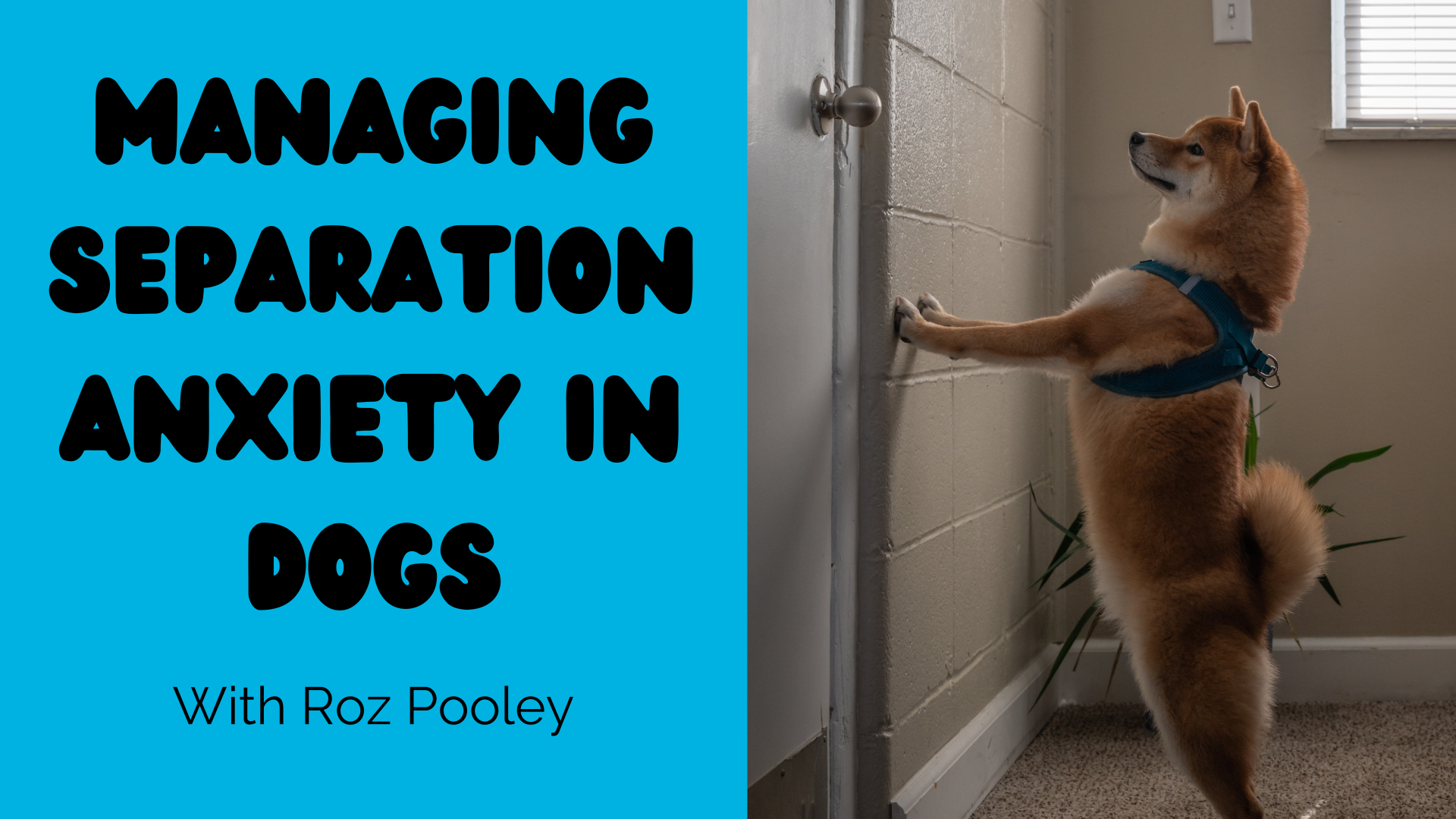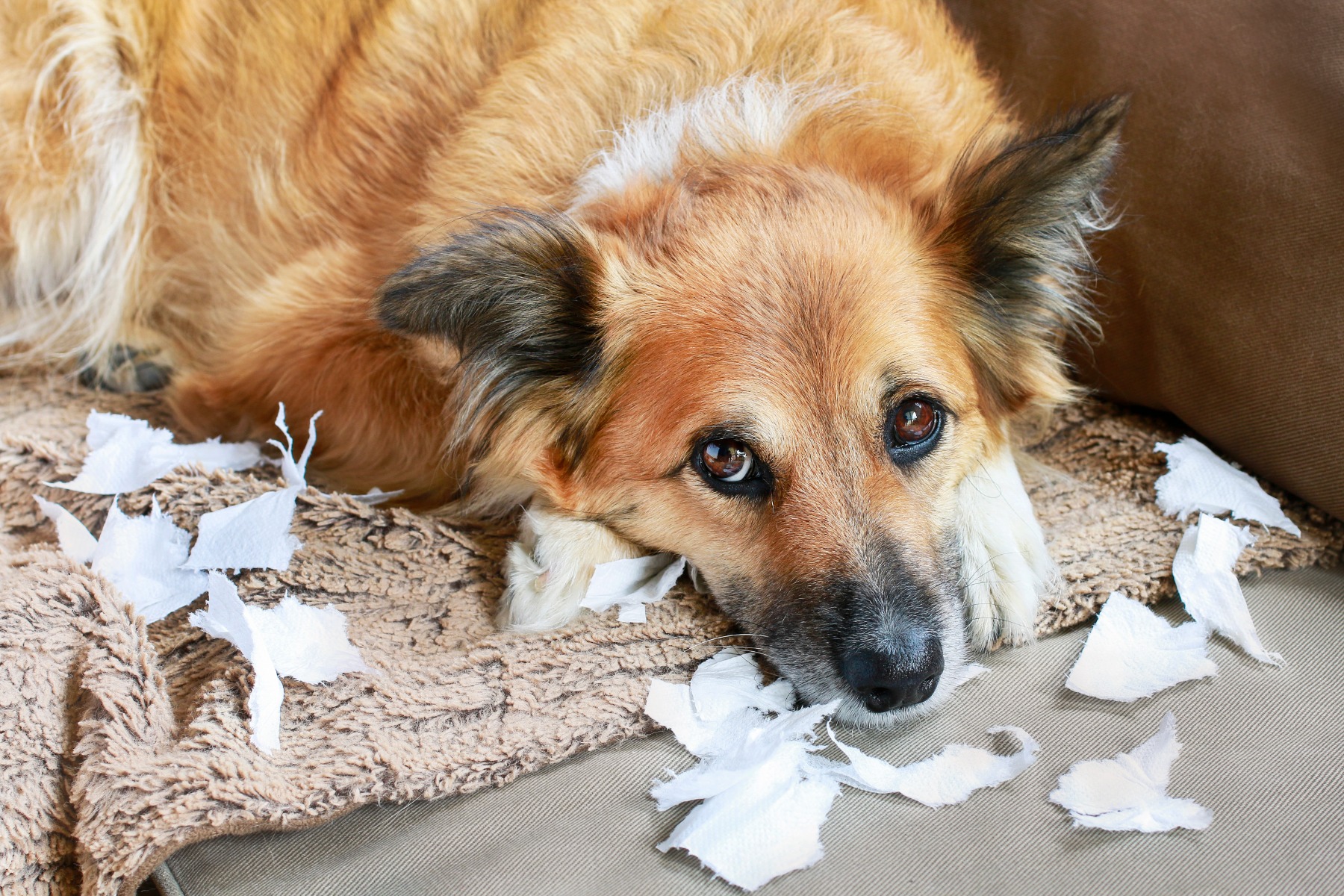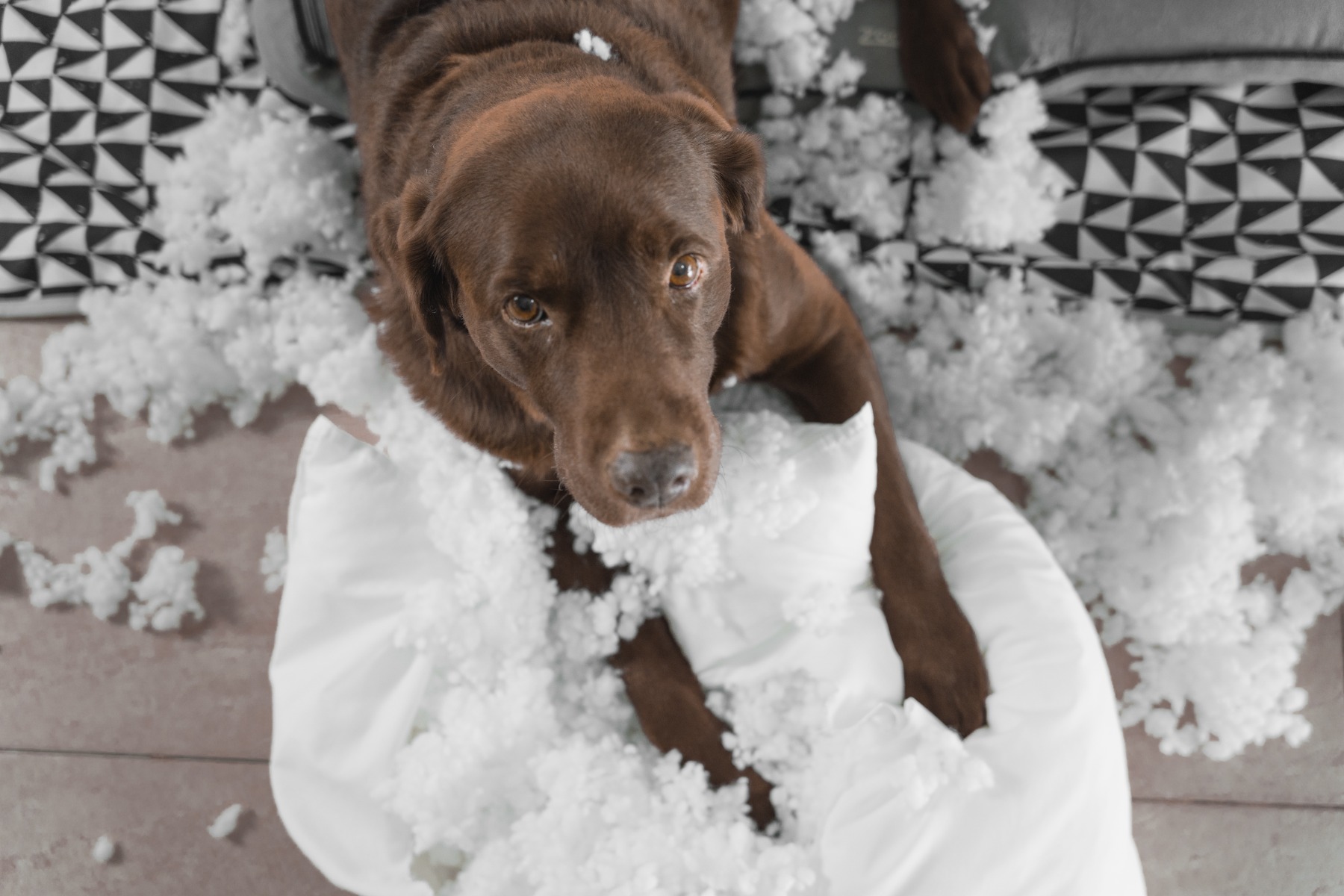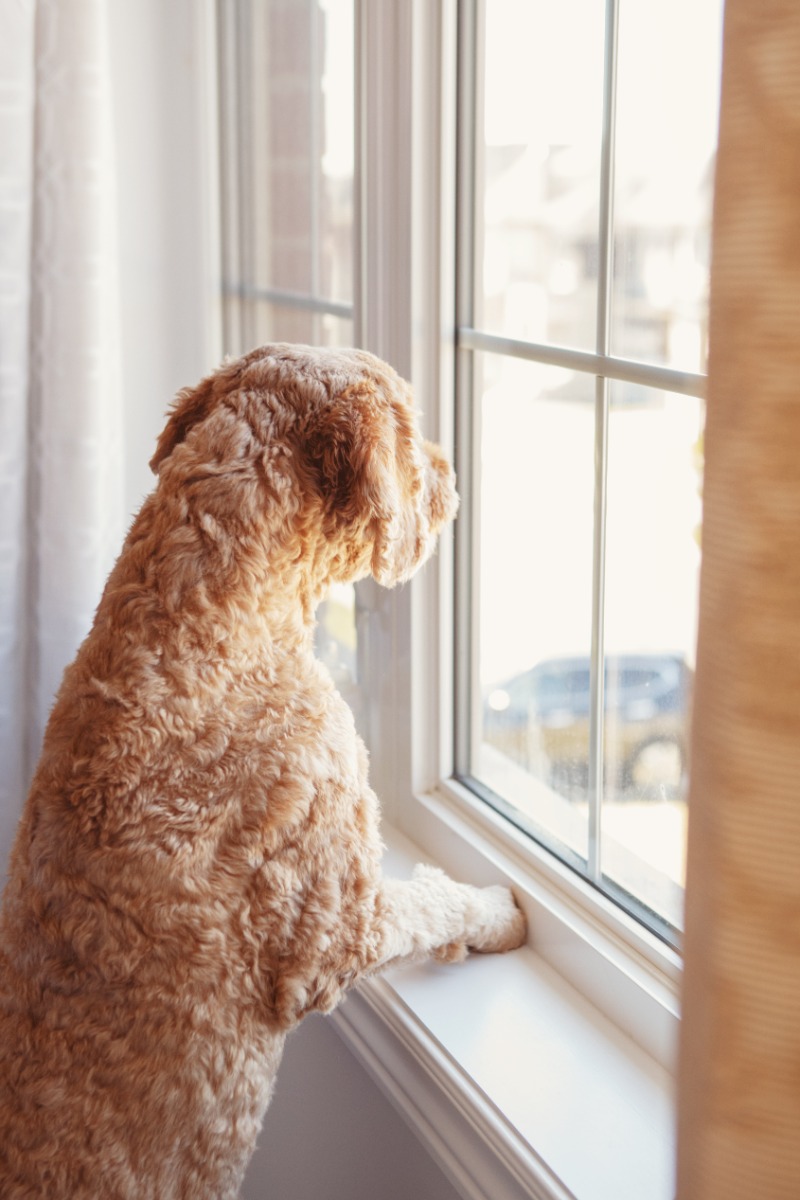Separation Anxiety in Dogs

Separation anxiety in dogs is a common problem behaviour, causing both dog and owners immense stress.
Signs of Separation Anxiety in dogs
Dogs who suffer from home alone distress may pace, whine, bark and howl when left alone. In some instances, they can become so distressed that they defecate and urinate.
Not all dogs with home alone distress will become destructive, but when they are it is often around exit points within the home, such as scratching and chewing at door and window frames. They may also chew items that are rich in the owner’s scent, such as TV remote controls and eye glasses.
General destructive behaviour can be related to boredom or over-arousal, but be mindful it’s not actually evidence of your dog being frustrated at being alone or clambering over surfaces trying to escape.

What causes Separation Anxiety in dogs?
Often there is a genetic component to separation anxiety, where the dog is genetically predisposed to not cope well with isolation. Afterall, the dog is a social species of animal.
Genetic predispositions may be due to their individual ancestry (the personality traits of their parents being passed down) or due to traits within the breed.
Some dogs may be inherently more anxious and thus need social security more than those with higher levels of confidence. Some breeds are bred to be highly social, such as Beagles who are bred for working in a group or being kept in close proximity or shared spaces in laboratories with other Beagles.
Working and companion breeds often have a greater attachment to humans due to the function of the breed- motivating them to find human company and cues more reinforcing than more independent breeds.
A dog’s learning history may also create negative associations with being alone.
This can stem from early puppy-hood when they were left to cry it out at night time, which can cause immense stress and lead to negative associations- that being alone is distressing. Others dogs may have been left alone while their owners went to work before they were ready to cope with that duration.
For others, separation anxiety in dogs can be triggered by other factors such as feeling unwell one day, being left alone while there’s scary building noise nearby or even being home alone during fireworks or a thunderstorm.
Some rescue dogs can develop strong attachments to their ‘rescuers’ due to a past of emotional trauma and struggle being left alone. However, in my experience they are not at an overall greater risk of home alone issues that dogs who were purchased as a puppy.
Excessive use of confinement may also contribute to anxiety and frustration, where the dog is unable to follow their owner around when in an active state. Multiple research papers have found confined dogs are more likely to show stress related behaviours when isolated.
Contrary to common advice, research has found that owners saying goodbye or greeting their four-legged friend does not contribute to separation anxiety in dogs. However, it’s advisable to do any departure or arrival greeting calmly so not to excite your dog.
Anxiety, Frustration or both?
Two emotions underpin home alone issues.
Anxiety is where the dog becomes worried about being alone and starts to show signs of anxiety when the owner prepares to leave. Once the owner has left their anxiety can escalate, resulting in high levels of distress.
Frustration is where the dog becomes frustrated that reinforcement from the owner’s presence (associated play, treats, company) is about to cease. These dogs often try to stop the owner leaving by blocking or jumping up at them. In extreme circumstances, they may even use aggressive behaviour to try and prevent their owner leaving. Sometimes these dogs settle down once the owner has left, while others may then become anxious for being alone once their owner has gone.
How to prevent Separation Anxiety in dogs developing?
If you have a puppy or a rescue dog, it’s important to first let them settle into their home. How long this takes varies from dog to dog, but it’s not unrealistic to expect this to take 2-4 weeks, or even longer! It depends on the dog!
Signs that your dog is settling in more are being less easily disturbed from a sleep and an absence of following you around the home.
If your dog or puppy doesn’t show signs of more independent behaviour around the home after a few weeks, it would be advisable to seek professional advice to help you progress out of this stage. The longer your dog gets use to having constant company, the harder it may be in the long-run. As baby steps are needed for some dogs, it’s advisable to get input from a qualified person rather than leave it for months.

How to deal with separation anxiety in dogs?
The most important thing is to set up a camera and to film your dog during a short absence. Ideally you should watch your dog live, so you can return when they show signs of becoming stressed.
If your dog shows signs of frustration or anxiety as you prepare to leave, you can see if they will engage in some food puzzle toys before you start getting ready and as you leave. If they do not, then they may be too anxious to eat, which will likely lead to anxiety when alone.
If they settle down and enjoy the food puzzles as you leave the house, it’s still important you film them to check that they continue to stay relaxed once the food puzzle has been finished. Using our Hemp Treats, containing functional ingredients for calming and managing restlessness is a great choice for puzzles or to be fed during anxious periods!
Remember to watch for long durations! Even if your dog is fine for five minutes or two hours, they may start to pace and wine after a period of time. You can purchase filming equipment or apps that notify you when your dog moves from a resting spot.
Oh no! My dog is not coping at all! What do I do?
It's advisable to arrange for dog care to help you avoid leaving your dog alone at all.
Every time you leave your dog alone longer than they can cope, you risk strengthening the negative associations your dog has with this context and associated cues.
This may include friends, family, other dog owners who are happy to have your dog over, dog walkers, dog day care or a pet sitter. The more support you enlist, the easier it will be to manage.
It may be expensive, but the stress of home alone issues can contribute to other behaviour problems developing. Furthermore, the ‘long-term’ stress hormone Cortisol inhibits the immune system response, which means that chronically stressed dogs are more vulnerable to disease. Vet treatment and behaviourists aren’t cheap, so consider pet care to be an investment in protecting your dog’s physical and emotional health.
How to treat separation anxiety in dogs, and help them cope being alone?
Once you have dog care support covered, you can start trying to teach your dog to cope being home alone. This is no mean feat and requires a huge amount of patience. If you rush the training, you can make you dog more resilient to progressing down the line.
If your dog shows anxiety at you picking up keys, turning off lights or putting on shoes or coats- it’s sensible to engage with these cues when you are not going anywhere. As you engage in the cues, ignore your dog so not to build anticipation. Try and engage with the cue for a duration that doesn’t cause your dog to become stressed.
Initial absences should be tried when the dog’s needs have been met. They have been walked, fed and experienced ample social interactions and mental stimulation.
If they are resting, you may opt to leave them be, rather than rouse them with food.
You should build up absences as and when your dog can cope. For example, you may first approach the door and then return back into the main part of the home. Once you can do this without your dog reacting, you may open and close the door, or step outside and return again.
Once you are leaving and closing the door, duration of absences should be built up in small increments. We are talking 5-10 seconds, not minutes! As your dog starts stays relaxed for 10 minutes or more, you may increase durations by 1-2 minutes at a time.
Sounds simple? Sadly, it’s not always so straight forward to treat separation anxiety in dogs. If you struggle with this training, it’s strongly advised you seek professional support from a suitably qualified person who uses kind and up to date methods. The ABTC register has a list of suitably qualified behaviourists.
Should I get another dog?
Tricky one, but generally we advise not to! As you may end up with two anxious dogs!
That said, you can run trials with your dog’s friends. Have them come over to stay with you present first, until they act like it’s their second home. Once both dogs are calm and relaxed sharing the space, you can trial a short absence and watch live on your camera to see how your dog copes with another dog present.
Sounds simple? Sadly, it’s not always so straight forward to treat separation anxiety in dogs. If you struggle with this training, it’s strongly advised you seek professional support from a suitably qualified person who uses kind and up to date methods. The ABTC register has a list of suitably qualified behaviourists.

Did our blog post help answer your questions about separation anxiety in dogs? Check out our other blog posts by Roz @ The Mutty Professor!




